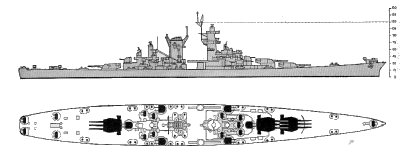![]() The Pacific War Online Encyclopedia
The Pacific War Online Encyclopedia
|
| Previous: Alaska | Table of Contents | Next: Alaska Scouts |
 ONI 222 |
|
Tonnage |
29,799 tons standard displacement |
|
Dimensions |
808'6" by 91'1" by 32'4" 246.43m by 27.76m by 9.86m |
|
Maximum speed |
33 knots |
|
Complement |
1517 |
| 2 catapults 4 seaplanes |
|
|
Armament |
3x3 12"/50 guns 6x2 5"/38 dual purpose guns 14x4 40mm Bofors AA guns 34x1 20mm Oerlikon AA guns |
| 4720 tons 9" (229mm) belt sloped to 10 degrees (equivalent to 12" or 305mm) and tapered to 5" (127mm) at the bottom edge 10.2" (260mm) bulkheads closing the citadel 3.75" (95mm) main deck, tapered to 2.8" (71mm) inboard 10.6" (270mm) steering sides and bulkheads 1.5" (38mm) steering roof 0.75" (19mm) splinter deck 1.4" (36mm) upper deck 13" (330mm) barbette 12.8"/6"/5.2"/5" (325mm/152mm/133mm/127mm) turret face/side/rear/roof 10.6"/5" (269mm/127mm) conning tower side/roof 9'10" underwater protection Immune zone 21,600-28,800 yards against 12" (305mm) shells |
|
| Machinery |
4-shaft General Electric
geared turbine (150,000 shp) 8 Babcock & Wilson boilers |
|
Bunkerage |
3619 tons fuel oil |
|
Range |
12,000 miles (19,300 km) at 15 knots |
| Sensors |
SK air
search radar 2 SG-1 surface search radar 2 Mark 8 fire control radar 2 Mark 12/22 fire control radar |
| Modifications | No significant modifications during their short period of Pacific War service. |
The Alaskas were completed in 1944 as "large cruisers", which has sometimes been characterized as a euphemism for battle cruisers. They were not true battle cruisers, and Friedman discusses their design history in his volume on cruisers rather than his volume on battleships. Their role was not to scout for the fleet, but to provide carrier escort, and they lacked the underwater protection of true battle cruisers. Their armor protection of 4720 tons constituted 16.4% of their displacement, on the high side for a heavy cruiser but much less than the 30% of a true battle cruiser like the British Hood.
The Alaskas
formed the heavyweight tier of a three-tiered post-treaty cruiser family conceived in
1939. With war looming, the other two tiers were rushed into
construction as the Baltimores and the Clevelands, whose designs were still
influenced by treaty restrictions. It was inevitable that the Alaskas
would be the largest departure from the treaty designs, since they
fell into the displacement range between battleships and
traditional cruisers that the treaties had specifically created.
As a result, work on the Alaska design continued even as
the Baltimores and Clevelands were laid down and
the design of their successors (the postwar Des Moines and
Worcesters) began.
The large cruiser concept was originally a response
to the German pocket battleships, which were seen as
"cruiser-killers" capable of catching and destroying conventional
cruisers. There were also rumors
that the Japanese had something
similar in the works, which the Japanese were in fact planning but
never built. The Alaskas became a pet project of King, then serving on the
General Board, who saw them as the ideal escort for carriers
making independent raids. The
greatest threat to such raiding forces was assumed to be enemy
heavy cruisers. King was encouraged in this by Roosevelt, who is
sometimes unfairly blamed for the Alaskas.
The Alaskas
must be counted as one of the few design failures by the U.S. Navy
during this period. They were an utterly unnecessary design,
doing nothing that an Iowa
did not do better, and doing most things much worse; and, at $75
million apiece, they were not that much cheaper than the Iowas.
Among their specific flaws was atrocious maneuverability, poor
subdivision, the aforementioned inadequate torpedo protection, the use
of a single exhaust uptake, and poor antiaircraft direction
that made the effective antiaircraft firepower little better than
that of a heavy cruiser. About their only strengths were a decent
main armament and beautiful lines.
They might have been much better: Though the basic concept was flawed, some of the preliminary designs would at least have led to a decent mini-battleship like the French Dunkerques or a more balanced large cruiser. The grotesque final product was probably a case of too many cooks spoiling the broth, as the design process seems to have attracted an unusual amount of attention. The Navy could seemingly never really reach consensus on whether they were to be true cruisers suitable for independent operations, carrier escorts, or a fast wing of the battle line. Lack of consensus on their proper role led to such poor design choices as aircraft catapults amidships, appropriate for scouting cruisers but not for carrier escorts.
| arrived 1945-1 | |
| arrived 1945-1-24 |

|

|

|

|

|
 |
References
Gogin
(2010; accessed 2012-12-1)
The Pacific War Online Encyclopedia © 2007-2008, 2012, 2014, 2019 by Kent G. Budge. Index